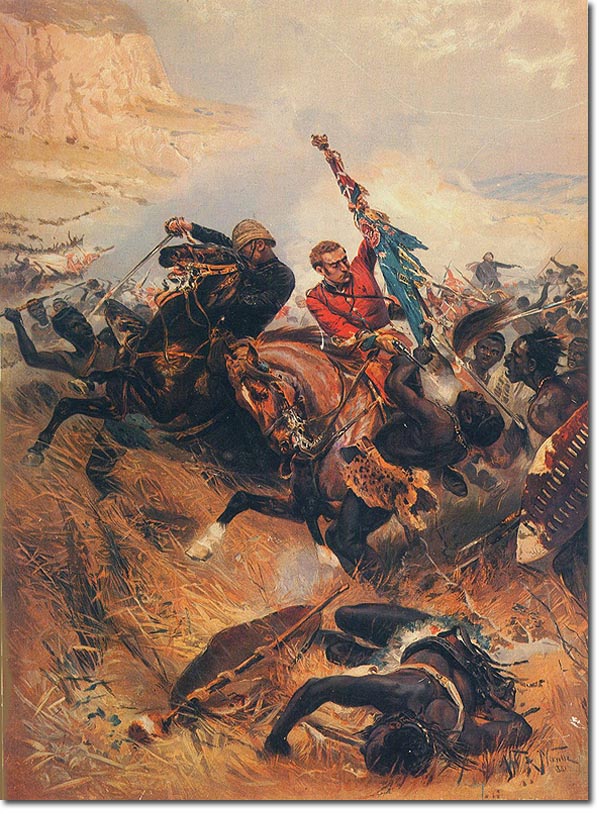|
|

 |
|
The French painter Alphonse de Neuville had achieved prominence in Britain in 1879 when his painting 'Le Bourget' was exhibited. It depicted a scene from the Franco Prussian War. The news from Zululand, however, prompted the Fine Art Society to commission him to paint the 'Defence of Rorke's Drift' which he completed in early 1880. He followed this up with two further commissions in June 1882: 'Saving the Queen's Colours' and 'The Last Sleep of the Brave'. Both pictures depicted the bravery of Lieutenants Melvill and Coghill who were awarded the VC for saving the Queen's Colour.
The painting shows the two officers mounted and fighting off the pursuing Zulus but it is incorrect for at least two reasons. The officers were leaving the battlefield of Isandhlwana which took place on 22nd Jan 1879. Every soldier who remained on the battlefield was killed by the massive Zulu army which encircled the British camp and wiped out the defenders. The only survivors were the ones who managed to escape on horseback. One of these escapees was Lieutenant Horace Smith-Dorrien of the 95th Regiment who was acting as transport officer to the column. He later achieved fame as a general in World War 1, but he also wrote an account of the battle and the flight to Helpmakaar beyond Buffalo River. As he was riding along he was overtaken by Lieutenant Neville Coghill of the 1st Battalion 24th. He described him as wearing a blue patrol jacket and cord breeches, and riding a red roan horse. Half a mile behind Coghill was Lieutenant Melvill, wearing a red coat and carrying the cased Colour across the front of his saddle. The casing was half off and hanging down. Smith-Dorrien points out that the two officers were not riding together and asks why Coghill was there at all as he was the orderly officer on Colonel Glyn's staff and Glyn was not on the battlefield. Coghill's first sight of Melvill was after he had crossed the Buffalo River. He saw Melvill in the river, his horse had been shot, but he still had the Colour. Coghill and an officer of the Natal Contingent, Higginson, rescued Melvill and brought him to the opposite bank of the river. They were unmounted and Higginson left them to find horses. While he was gone the Zulus caught up with the two officers and killed them. So at no time did Melvill and Coghill fight together on horseback. The Colour shown in this painting, and in the second painting, where the two dead officers are discovered, is the Regimental Colour but it was in fact the Queen's Colour which was a Union Flag with XXIV in the middle. Melvill alone had been given the task of saving the Colour, Coghill just happened to be there to assist him across the river. |
Regimental details | Regimental Colours
Armed Forces | Art and Culture | Articles | Biographies | Colonies | Discussion | Glossary | Home | Library | Links | Map Room | Sources and Media | Science and Technology | Search | Student Zone | Timelines | TV & Film | Wargames